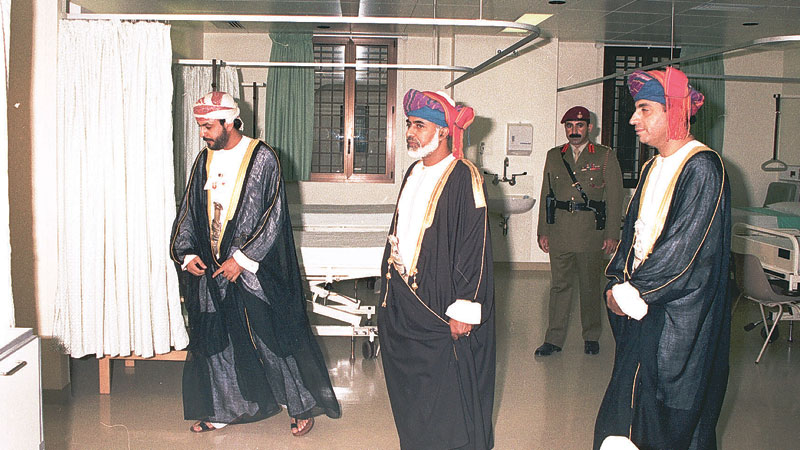


The spectacular transformation of Oman as a primitive country in the early seventies to a modern country with all excellent facilities for a civilised living within a short time in history is the greatest contribution of His Majesty Sultan Qaboos to Oman and its people.
This is possible only because His Majesty sets up a role model to His Majesty’s government and to Omanis in general.
I landed in Oman on April 18, 1971 for a locum assignment of a surgeon’s vacancy for two months at Arrahma Hospital (the then American Mission Hospital) Muttrah. This was the only main hospital for the entire country at that time, and the hospital is not in existence at present.
That locum surgeon became an Omani citizen and I got the wonderful opportunity to witness the tremendous changes to uplift Oman to its present stage by the guidance and leadership of His Majesty.
Living conditions in Oman at that time were very poor. There was no electricity, no water supply, no sanitation, no roads; facilities for education and health were very meager and non-availability of many food items.
With a group of dedicated people comprising Omanis and expatriates in the different ministries under His Majesty’s government, the picture of Oman started changing rapidly in all fields under the many five-year plans.
His Majesty Sultan Qaboos used to get first-hand information about the people and their problems from the annual ‘Meet The People’ tour, and he formulated and implemented policies for the development based on the feedback from the people.
His Majesty proved to be an amalgam - what is best for a ruler, a benevolent leader, a visionary, a disciplined chief with the total dedication and determination for the improvement of Oman and its people and a peacemaker to the entire world.
His passing away is a great loss to Oman. We wish and pray that the spirit of Renaissance will be continued with prosperity and peace in Oman under the wise leadership of his successor His Majesty Sultan Haitham bin Tarik.
In the field of health service, Oman achieved tremendous progress. The communicable and infectious diseases were completely controlled and eradicated by health education, immunisation and so on through the health centres and other medical institutions.
Primary Health Care facilities were tremendously improved. Now there is a health care facility even in the remotest Governorate of Oman. Tertiary care Hospitals such as Al Nahdha Hospital, Khoula Hospital, Royal Hospital and Sultan Qaboos University Hospital were started in Muscat and Sultan Qaboos Hospital at Salalah.
modern outpatient clinics
All district hospitals of Oman were upgraded with modern outpatient clinics, laboratory services, X-rays, CT Scan & MRI, well-equipped operation theatres, separate wards for male, female and children in addition to specialty wards.
In addition to the basic specialties such as medicine, surgery, maternity and child care, sub-specialty services such as orthopedics, ENT, ophthalmology, skin and VD, dental, plastic and reconstructive and neurology Services are available in these hospitals.
According to records published by the Oxford Business Group at the end of 2016, the Ministry of Health (MoH) had 74 hospitals with a total of 6,589 beds (equivalent to 14.9 per 10,000 people) as well as 266 governmental health centres, clinics and pharmacies, and 1,105 private clinics.
Government hospitals for the general Omani public accounted for 49 hospitals and 4,659 beds, while the private sector accounted for 15 hospitals with 637 beds. The rest of beds operate under Armed Forces, the Royal Oman Police (ROP) and Sultan Qaboos University.
Training of the human resources in the medical service such as doctors, nurses and paramedical staff from the Omani population were started and going on smoothly. Medical colleges, nursing schools, training centres for para-medical staff are available in Oman under government and private establishments.
Doctors and nurses are sent abroad for specialised services and on their return super-specialty services are started in the tertiary care hospitals.
Health Care Systems including referral of patients were routed in a Pyramidal Structure, starting from Health Centres, District Hospitals and Tertiary Care Centres.
‘Treatment Abroad’ was very common in the past in Oman became a rarity by the advancement of medical facilities and availability of the trained doctors and the supportive staff in Oman. As proclaimed by His Majesty Sultan Qaboos in 1970, health and education are totally free to people of Oman.
This achievement is praiseworthy of the health service in Oman when considering only two hospitals were available in the whole of Sultanate in 1970 when His Majesty Sultan Qaboos came to power and this fact was well appreciated and applauded by international agencies like Unicef and WHO.
The future of health service in Oman is promising and the younger generations of Oman have a great responsibility to maintain this development and promote the health service in Oman to greater heights. This is possible with a well-planned far sighted approach to have a uniform upgraded health care in the nook and corner of the entire country of Oman.
Hope and pray this is possible in the years ahead.
Dr Chona Thomas is a senior consultant plastic surgeon and former head of plastic surgery service, Sultanate of Oman. Email: chonathomas@gmail.com -
Oman Observer is now on the WhatsApp channel. Click here



